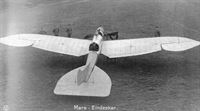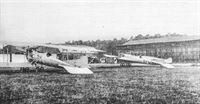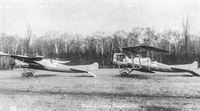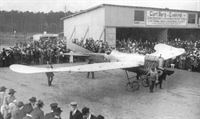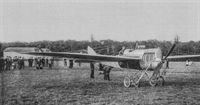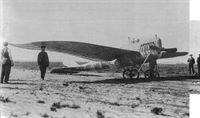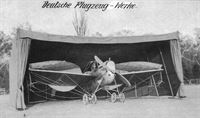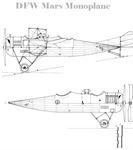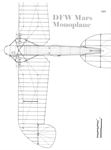
Описание
Страна: Германия
Год: 1912
Варианты
- DFW - Mars - 1912 - Германия
- DFW - Mars biplane - 1912 - Германия
- А.Александров, Г.Петров Крылатые пленники России
- J.Herris DFW Aircraft of WWI (A Centennial Perspective on Great War Airplanes 29)
- Jane's All The World Aircraft 1913
- P.Grosz, G.Haddow, P.Shiemer Austro-Hungarian Army Aircraft of World War One (Flying Machines)
- E.Hauke, W.Schroeder, B.Totschinger Die Flugzeuge der k.u.k. Luftfahrtruppe und Seeflieger 1914-1918
- Журнал Flight
-
J.Herris - DFW Aircraft of WWI /Centennial Perspective/ (29)
DFW Mars monoplane pre-war.
-
M.Dusing - German & Austro-Hungarian Aero Engines of WWI. Vol.3 /Centennial Perspective/ (66)
DFW Mars monoplane 00.01 (w/n 24) on the DFW airfield in Leipzig on 20 May 1913, prior to delivery. For LA flight trials a Hiero four-cylinder engine was installed.
This early DFW Mars monoplane was powered by a 4-cylinder engine, perhaps a NAG F 3 which the Mars was known to use. Mars monoplanes and biplanes used a variety of 4-cylinder and 6-cylinder engines. Like most aircraft of the type it used wing warping.
Three-quarter rear view of a D.F W. monoplane, school type. It will be noticed that this machine is almost exactly similar to the military type, except for the steel bridge girder underneath the wings. -
Журнал - Flight за 1913 г.
Three-quarter rear view of the D.F.W. military monoplane.
-
J.Herris - DFW Aircraft of WWI /Centennial Perspective/ (29)
THE MILITARY COMPETITIONS. - The Mars monoplane, entered by Mr. C. E. Kny and constructed by the Deutsche Flugzeug Werke at Leipzig. It will carry the No. 23 in the Military Trials.
DFW Mars monoplanes powered by a six-cylinder engines; the gravity tank above the fuselage is distinctive. (Peter M. Bowers Collection/Museum of Flight) -
J.Herris - DFW Aircraft of WWI /Centennial Perspective/ (29)
The DFW Mars monoplane had a distinctive wing planform; this one had ailerons instead of wing warping. (Peter M. Bowers Collection/Museum of Flight)
-
J.Herris - DFW Aircraft of WWI /Centennial Perspective/ (29)
DFW Mars monoplane at right with "DFW" and Mars biplane at left. Both types were built in small numbers and used for training and reconnaissance in the opening months of the war. Their fuselage and vertical tails were very similar. (Peter M. Grosz Collection/SDTB)
Другие самолёты на фотографии: DFW Mars biplane - Германия - 1912
-
J.Herris - DFW Aircraft of WWI /Centennial Perspective/ (29)
DFW Mars monoplane at left and Mars biplane at right. Both types were built in small numbers and used for training and reconnaissance in the opening months of the war. Their fuselage and vertical tails were very similar. (Peter M. Bowers Collection/Museum of Flight)
Другие самолёты на фотографии: DFW Mars biplane - Германия - 1912
-
J.Herris - DFW Aircraft of WWI /Centennial Perspective/ (29)
A DFW Mars monoplane at a pre-war flying exhibition. (Peter M. Grosz Collection/SDTB)
-
J.Herris - DFW Aircraft of WWI /Centennial Perspective/ (29)
The D.F.W, monoplane on which Lieut, von Hiddesen secured the first prize in the Prince Henry Reliability Trials some time ago.
Another DFW Mars monoplane powered by a six-cylinder engine. The DFW Mars, produced in monoplane and biplane variants, was one of the miscellaneous primitive types with which Germany entered the war. These aircraft were used in small numbers during the first months of the war until replaced by more reliable aircraft of higher performance. The four-wheel undercarriage was a characteristic of the Mars monoplanes and biplanes. -
J.Herris - DFW Aircraft of WWI /Centennial Perspective/ (29)
A DFW Mars monoplane powered by a six-cylinder engine before the war. (Peter M. Bowers Collection/Museum of Flight)
-
J.Herris - DFW Aircraft of WWI /Centennial Perspective/ (29)
DFW Mars monoplanes powered by a six-cylinder engines; the gravity tank above the fuselage is distinctive. (Peter M. Bowers Collection/Museum of Flight)
-
J.Herris - DFW Aircraft of WWI /Centennial Perspective/ (29)
A DFW Mars monoplane demonstrates its ability to fold its wings to fit into a tent, a requirement at the time. (Peter M. Grosz Collection/SDTB)
-
J.Herris - DFW Aircraft of WWI /Centennial Perspective/ (29)
DFW Mars monoplane in flight reveals its distinctive wing and tail profiles. (Peter M. Grosz Collection/SDTB)
-
Журнал - Flight за 1913 г.
Lieut, von Hiddessen on hts D.F.W. monoplane on which he won the three days' "Prince Henry Reliability Trials." The machine is constructed by the "German Aircraft Works" at Leipzig.
-
J.Herris - DFW Aircraft of WWI /Centennial Perspective/ (29)
DFW Mars monoplane
-
J.Herris - DFW Aircraft of WWI /Centennial Perspective/ (29)
DFW Mars monoplane
-
J.Herris - DFW Aircraft of WWI /Centennial Perspective/ (29)
DFW Mars monoplane
-
J.Herris - DFW Aircraft of WWI /Centennial Perspective/ (29)
DFW Mars monoplane
-
Журнал - Flight за 1913 г.
THE D.F.W. MONOPLANE. - Plan, side and front elevation to scale.
А.Александров, Г.Петров Крылатые пленники России
К первому января 1911 г. в Германии 46 человек получили пилотские дипломы, тогда как в России подобными грамотами могли похвастаться лишь семь человек. Ровно через год соотношение почти выравнилось, приняв вид 133 против 103. То ли наши меньше летали, то ли были более опытными и везучими, но по числу катастроф германцы оказались впереди, со "счетом" 13 к 4 ( в 1910-1911 гг. в России погибли 7 авиаторов). Июль 1912 г. ознаменовался первым грандиозным международным перелетом российского пилота В. М. Абрамовича, преодолевшего с 1-го по 24-е (с пассажиром на борту) 1600 км по маршруту Берлин - Петербург за 17 часов. На аэроплане "Райт" (Wright) немецкого производства Абрамович спешил на 2-й конкурс отечественных военных самолетов, организованный Военным ведомством и открывшийся в столице 21 августа. Помимо "Райта" вне программы участвовали моноплан и биплан "Марс", пилотируемые Генрихом Биром (Heinrich Bier), и моноплан "Паук" (Spinne) под управлением Энтони Фоккера и его друга Илгерса (Anthony Fokker, Hilgers). Последний пытался покорить публику, паря в течение 6 минут с руками, поднятыми над головой, но ни его фокусы, ни усилия самого Фоккера не привели к получению заказов. Немудрено: оснащенный таким же мотором "Аргус" (Argus) 100 л.с, победитель соревнований биплан И. И. Сикорского С-6Б превосходил "Паука" по скорости, скороподъемности и величине полезной нагрузки, хотя "показатели удобства спуска (неприхотливость к условиям посадочной площадки) и стрельбы, а также некоторые необязательные качества были немного выше у немецкого аэроплана". Аппарат Фоккера все же завоевал сердце авиаторши Л. А. Галанчиковой, которая отправилась в Йоханисталь (близ Берлина), приобрела подобный самолет и научилась управлять им. Аппараты "Марс" и "Паук" (с Фоккером в задней кабине) изображены на снимках 1 и 2, а и б.
Описание:





